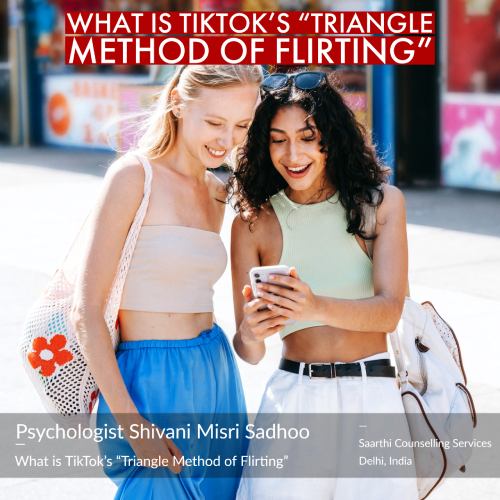Decodes Couples Counselor Shivani Sadhoo
In today’s fast-paced world, flirting is both exhilarating and vital. It injects excitement and playfulness into our lives, providing respite from the monotonous routine. Over the centuries, flirting has evolved as an art form, and the Triangle Method has emerged as a favored technique to enthrall and captivate potential romantic interests.
Let’s learn more about it from Shivani Misri Sadhoo, India’s leading psychologist and marriage counselor.

What is the triangle method?
The Triangle Method is a graceful flirting technique where you establish a connection through your gaze. Visualize an inverted triangle on the person’s face. Engage their left eye momentarily, then shift your gaze to their mouth, and finally return to their right eye. This subtle eye movement silently conveys interest and connection, emphasizing the captivating “Golden Triangle” formed by the eyes, forehead, and mouth.
Extended eye contact can trigger the release of phenylethylamine, generating attraction and stimulating oxytocin for bonding. However, avoid intense gaze to prevent discomfort. Aim for a flirtatious, friendly, and approachable demeanor to make the other person feel comfortable engaging in conversation.
What are the pros?
1. Non-threatening Approach: By using the triangle method, you create a relaxed and non-threatening atmosphere that makes the other person feel comfortable. For instance, you can engage in light-hearted conversation, maintain eye contact, and occasionally glance away to ease any tension.
2. Subtle and non-verbal: The triangle method allows you to convey your interest non-verbally, which can be advantageous in certain situations where you may not want to be too direct or obvious. It can create an air of mystery and intrigue. For example, make a light-hearted joke about a movie you both like.
3. Eye contact: Engaging in eye contact is an important aspect of flirting, as it can establish a connection and show your genuine interest. The triangle method guides your eye movement, ensuring that you maintain eye contact with the person you’re flirting with.
4. Effective Flirting tool: Some people find the triangle method to be an effective technique for conveying romantic or sexual interest. It can be a part of a larger flirting repertoire and may help initiate a flirtatious interaction.
5. Building Trust: By employing the triangle method, you gradually build trust and create a foundation for further interaction. Trust is crucial in developing a meaningful connection, and by being respectful, attentive, and authentic, you establish a sense of trustworthiness.
What are the cons?
1. Misinterpretation: Non-verbal cues can be easily misinterpreted, and the triangle method is no exception. By intentionally creating ambiguity and sending mixed signals, the triangle method can lead to confusion and misinterpretation. For instance, a person might think you’re not interested and move on, or they might become frustrated by the lack of clarity.
2. Cultural differences: Different cultures have varying norms and expectations regarding eye contact and flirting. What may be considered appropriate or appealing in one culture may not be in another. It’s essential to be mindful of cultural contexts to avoid misunderstandings or potential discomfort.
3. Emotional strain: Constantly maintaining a “mysterious” persona can be emotionally exhausting and potentially lead to anxiety or stress. It can also strain relationships when one person feels misled or frustrated.
4. Lack of authenticity: This approach can prevent genuine and open communication, hindering the development of a strong emotional connection. It may lead to shallow interactions built on facades rather than authentic connections.
5. Missed opportunities: The triangle method may cause you to miss out on potential connections or relationships. By withholding interest or being evasive, you might push away individuals who genuinely wanted to get to know you.
Now that you know about this innovative technique, would you like to try it?

Shivani Misri Sadhoo is an internationally recommended relationship Counsellor by world’s biggest and most trusted study and research-based foundation for couples therapy – Gottman Institute. She is trained on specialised key relationship counselling Skills from AIIMS, VIMHANS and various other reputed institutions. Counselor Shivani Misri Sadhoo, is also Certified for Emotionally Focused Therapy, Cognitive Behavioral Therapy and Dialectical Behaviour Therapy.
Counsellor Shivani Misri Sadhoo is also a Certified Neuro Linguistic Practitioner with specialised training and experience in the field of affairs/betrayals, trust issues, difficulty communicating, conflicting values, bereavement, grief and loss (affairs, separation, divorce, childhood) and emotional health issue (anxiety, social anxiety, fear, depression, low mood).
Currently, Shivani Misri Sadhoo is one of the top counsellors with the HIGHEST Success Rate with over 17,000 happy couples and individuals (based in India and abroad), who has benefited from her therapy. Psychologist and Counselor Shivani Misri Sadhoo not only practice independently from her clinic in Greater Kailash, Delhi, India but also listed on the panel of eminent hospitals like IBS Hospital – Institute of Brain & Spine, Express Clinic, Fortis (formerly) based in Delhi.



